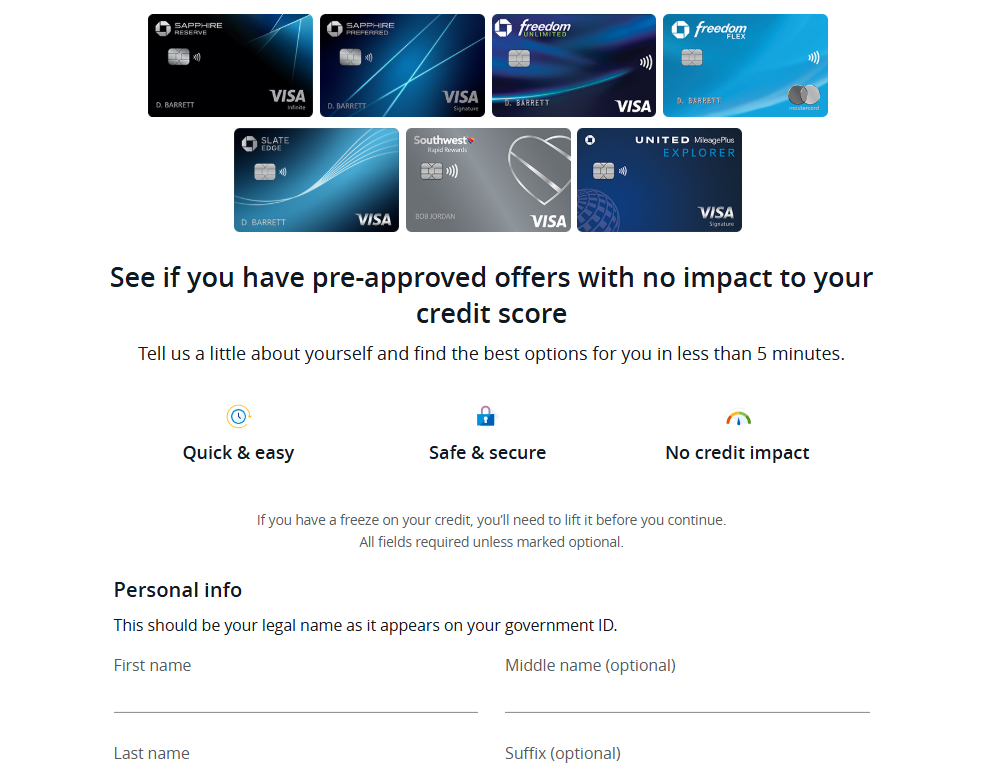How to get preapproved for a Chase credit card

Key takeaways
- Getting preapproved for a credit card helps determine the likelihood that you’ll be approved for a card without affecting your credit score.
- Chase offers several different preapproval options, including a free preapproval tool and targeted preapproved offers.
- Most Chase cards require good to excellent credit for approval, so be sure that your credit score meets the requirements prior to submitting an application.
- Receiving a preapproval for a Chase card does not guarantee that you’ll be approved when you submit your application, but it does mean that approval is likely.
Chase offers some of the top rewards credit cards on the market, but qualifying for one of these cards isn’t necessarily an easy feat. Most Chase credit cards require good to excellent credit for approval, and the Chase 5/24 rule limits how many new credit cards a consumer can open over a specific time span. In other words, if you’ve opened 5 or more credit cards from any issuer within 24 months, you’re unlikely to be approved for a new Chase card.
Fortunately, there are several ways to see if you’re preapproved for a Chase credit card. For instance, Chase has a tool on its website that allows you to easily check if you’re preapproved for any credit card offers. If you’re an existing Chase cardholder, you might also receive targeted offers directly in your online account or through the mail. Alternatively, Bankrate’s CardMatch™ tool can also help you determine which offers you may be preapproved for.
How to get preapproved for a Chase card
Before we dive in, know that Chase will only perform a soft inquiry on your credit report to see if you’re prequalified for a card offer. Unlike a hard inquiry, which can negatively impact your credit score, a soft inquiry has no effect on your credit score.
Additionally, keep in mind that a prequalified Chase offer is not a guarantee of card approval. This step only ensures you’re likely eligible for a Chase credit card based on your income, your credit and other factors. To get a Chase credit card, you will still need to apply for the card you’re interested in, which will require a hard credit check.
On Chase’s website
Getting preapproved for a Chase credit card is as simple as checking the issuer’s site to see which card(s) you’re preapproved for. On this page, simply enter personal details like your first and last name, street address and your Social Security number. Then click “Find My Offers” to see if there are any cards you’re preapproved for.

It’s important to note that Chase sometimes removes its preapproved offers page, which makes the process of checking for offers a bit more complicated. But it’s not impossible if you know where to look.
Through your Chase account
If you’re an existing Chase cardholder, you can check for preapproved credit card offers once you log in to your account. To do this, follow these steps:
- Log in to your Chase account via desktop or mobile.
- Click on “Explore products” on the main navigation menu.
- Select “Just for you” to view your current targeted offers from Chase.
- Browse for any credit card prequalifications.
In your mailbox
In addition to targeting current users via their Chase account, Chase is also known to target potential cardholders via snail mail. Keep an eye out for any mailers promoting popular Chase cards, and be sure to scan for prequalification language.
CardMatch offers
Another great way to see if you prequalify for one of the issuer’s credit cards is by using Bankrate’s CardMatch™ tool. Like other prequalification tools, CardMatch issues a soft pull to your credit — which means there’s no impact to your credit score.
In this tool, you’ll enter basic information like your name, street address, employment status, income, email address and the last four digits of your Social Security number. You’ll then be matched with qualifying card offers from a variety of issuers, including Chase.
The one major benefit of taking this route is that, even if you don’t qualify for a Chase card, you might find an offer from another issuer that is better for you. Keep in mind, however, that a preapproved offer in CardMatch doesn’t guarantee you’ll be approved for a card when you apply.
Best Chase cards for preapproval
There are many top Chase credit cards you might be targeted for or preapproved for, including:
- Chase Sapphire Preferred® Card
- Chase Sapphire Reserve®
- Chase Freedom Unlimited®
- Chase Freedom Flex®*
- Chase Slate Edge℠*
The Chase Sapphire Preferred and Chase Sapphire Reserve are ideal for consumers who want to earn flexible travel rewards (or luxury travel perks), whereas the Chase Freedom Unlimited and Chase Freedom Flex are better suited to anyone who wants to earn cash back without paying an annual fee. As for the Chase Slate Edge, this card is best for consumers who are interested in transferring a balance or paying off a large purchase over time.
How to increase your chances of preapproval for a Chase card
There are several steps you can take to increase your chances of being prequalified — and approved — for a Chase credit card:
- Check your credit score. Before applying for any credit card, make sure you check your credit score. When it comes to Chase, you’ll likely need at least good credit (670 or higher) to qualify for cards like the Chase Freedom Unlimited, Chase Freedom Flex or Chase Slate Edge. To qualify for the Chase Sapphire Preferred and Chase Sapphire Reserve, you’ll likely need very good (740 or higher) to excellent credit (800 or higher). However, you’ll likely have the best odds of approval for any Chase card if your credit score is in the very good to excellent range. If your credit score falls below this range, you may need to improve your credit before you can qualify for a Chase card.
- Pay your bills early or on time. Your payment history is the most important factor when determining your FICO score. Paying all your bills early or on time is a smart way to ensure your credit score stays in good shape.
- Keep your credit utilization low. The second most important factor that makes up your FICO score is your credit utilization — or the amount you owe in relation to your credit limit. It’s generally recommended to keep your credit utilization below 30 percent, but there’s no hard and fast number that will guarantee success.
- Count all of your household income in applications. Individuals over the age of 21 can list household income when applying for credit, which can be helpful for spouses who stay home or don’t work but have access to income otherwise. With that in mind, make sure you’re listing your household income, not just your personal income, on any credit card applications.
- Don’t apply for too many credit cards over a short span of time. Finally, remember that you’re unlikely to get approved for a Chase credit card if you’ve applied for too many new cards recently. If you’ve gotten more than 5 new cards in the last 24 months, you may need to wait a year or longer to apply for the Chase credit card you want.
The bottom line
Getting preapproved for a Chase credit card helps you gauge whether you’re likely to be approved without requiring a hard inquiry on your credit report. On the downside, remember that preapproval doesn’t guarantee you’ll get the card you want.
So, should you get preapproved for a Chase card? If you plan to apply for a card anyway, then you have nothing to lose. Remember that you’ll face a hard credit inquiry any time you apply for a card, and your credit score will take a small but temporary hit — which is why using the preapproval process is a good way to determine your odds of approval without affecting your credit score.
*The information about the Chase Freedom Flex and Chase Slate Edge has been collected independently by Bankrate. The card details have not been reviewed or approved by the issuer.






